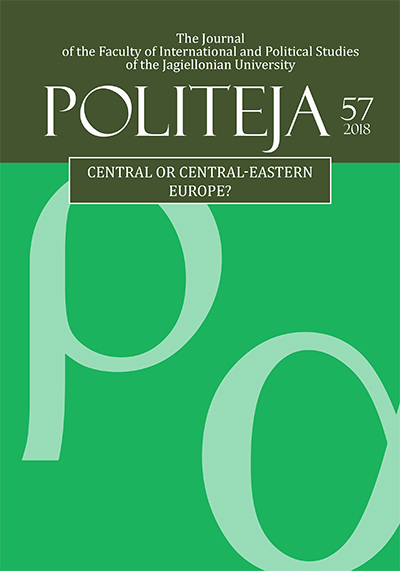Sclavinia – Intermarium? Or About One Missing Roman Province
Meridional Vector in East‑Central Europe. An Essay on Strengths and Weaknesses of Two Good Neighbors
DOI:
https://doi.org/10.12797/Politeja.15.2018.57.04Keywords:
Sclavinia, Intermarium, the Kingdoms of Hungary and Poland, Nitra Principatity, the Slovaks, the Slavs, the Hungarians, the PolishAbstract
If someone had sighed at the beginning of the 19th century that a unified German state would be formed in some time and Italy would able to unite itself, that one would certainly concerned to be a fool. Yet these ideas were realized in full around the year 1870. Few, however, realized that the 19th century by the accomplishing those political goals Europe came to a state that reminds the dearest dreams of the ideologists of the year 1000, who put forward a concept of European political arrangement built as an imaginary Tetrarchy consisting of 4 equal provinces Galia, Germania, Roma and Sclavinia. As it is clear, Sclavinia of these provinces, is still missing. The presented article attempts to give an overview of the implementation of the „Sclavinia project” with the assignment of its other names, such as Intermarium, throughout history. Martin Homza demonstrates this on mutual Slovak‑Polish relations, which considers the basic axis of this possible construction. Methodologically, these relations divids into 4 subcategories according to the strength and weakness of their bearers: Relation: Strong: Strong; Weak: weak; Weak: Strong and Strong: Weak.
Downloads
References
Bowlus Ch.R., Franks, Moravians, Magyars: the Struggle for the Middle Danube, Philadelphia 1995.
Czajka W., “Politické aspekty v poľsko‑slovenských vzťahoch v rokoch 1927-1938”, Historický časopis, vol. 35, no 2 (1987).
Duchoňová D., Duchoň, M, “Spiš v rokoch 1711-1769”, in M. Homza, S.A. Sroka (eds.), Historia Scepusii, vol. 2: Dejiny Spiša od roku 1526 do roku 1918, Bratislava–Cracow 2016.
Galli Anonymi Cronicae et Gesta Ducum sive Principum Polonorum, in C. Maleciński (ed.), Monumenta Poloniae Historica: Nova series, vol. 2, Cracow 1952.
Homza M., Balegová J. (ed., trans. and comment.), Uhorsko‑poľská kronika: Nedocenený prameň k dejinám strednej Európy, Bratislava 2009.
Homza M., “14. marec roku 1074 a jeho dôsledky na vývoj Nitrianskeho kniežatstva”, in R. Letz (ed.) Slovenské územie, Martin 2017.
Homza M., “La Grande Moravia tra Oriente e Occidente”, in E. Hrabovec, P. Piatti, R. Tolomeo (eds.), I Santi Cirillo e Metodio e la loro eredità religiosa e culturale ponte tra Oriente e Occidente: Raccolta di studi in occasione del 1150° anniversario della missione dei santi Cirillo e Metodio nella Grande Moravia (863–2013), Città del Vaticano 2015.
Homza M., “Svätá Kunigunda a Spiš”, in R. Gładkiewicz, M. Homza, M. (eds.), Terra Scepusiensis: Stav bádania o dejinách Spiša, Levoča–Wrocław 2002, 381–405.
Homza M., “Včasnostredoveké dejiny Spiša”, in M. Homza, S.A. Sroka (eds.), Historia Scepusii, vol. 1: Dejiny Spiša do roku 1526, Bratislava–Cracow 2009.
Chalupecký I., “Snahy Uhorska o vykúpenie spišských miest z poľského zálohu v 15.-17. storočí”, Historické štúdie, vol. 41 (2000).
Kłoczowski J. (ed.), Central Europe Between East and West, Lublin 2005.
Knoll W.P., Schaer F. (eds.), Gesta Principis Polonorum: The Deeds of the Princes of the Poles, Budapest 2003.
Kuzmová S., Preaching Saint Stanislaus: Medieval Sermons on Saint Stanislaus of Cracow: His Image and Cult, Warszawa 2012.
Labuda G., “Ze stosunków polsko‑węgierskich w drugiej połowie X wieku”, in J. Bardach, et al. (eds.), Europa – Słowiańszczyzna – Polska: Studia ku uczczeniu profesora Kazimierza Tynieckiego, Poznań 1970.
Magistri Vincentii dicti Kadlubek, “Chronica Polonorum”, in M. Plezia (ed.), Monumenta Poloniae Historica: Nova Series, vol. 11, Cracow 1994.
Malinovská N., “«Regnum Sclavorum» Svjatopolka kak istočnik srednevekovych slavjanskich koncepcii Sklavinii”, in Studia Slavica et Balcanica Petropolitana, vol. 21, no. 1 (2017).
Marsina R. (ed.), Codex diplomaticus et epistolaris Slovaciae, vol. 1, Bratislava 1974.
Najstarszy zwód prawa polskiego: Das äleste Gewohnheitsrechtsbuch, (ed. and trans.) J. Matuszewski, J. Matuszewski, Łódź 1995.
Rácz G. (ed.), Visegrád 1335, Bratislava 2009.
Semkowicz W. (ed.), Słowacja i Słowacy, vol. 2: Dzieje i literatura, Cracow 1938.
Suchý M., “Spišské mestá v poľskom zálohu”, in R. Marsina (ed.), Spišské mestá v stredoveku, Košice 1974.
Szczur S., Historia Polski: Średniowiecze, Kraków 2002.
Szűcs J., “Theoretical Elements in Master Simon of Kéza’s Gesta Hungarorum (1282-1285) ”, in Simon of Kéza, The Deeds of the Hungarians, L. Veszprémy (ed.), F. Schaer (trans.), Budapest 1999, XXIX‑CII.
Třeštík D., Vznik Velké Moravy, Praha 2010.
Wyrozumski J., Królowa Jadwiga. Między epoką piastowską i jagiellońską, Kraków 1997.
Downloads
Published
Issue
Section
License
Copyright (c) 2018 Martin Homza

This work is licensed under a Creative Commons Attribution-NonCommercial-NoDerivatives 4.0 International License.






